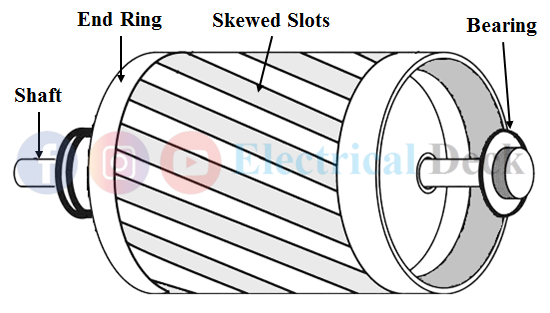Sometimes the induction motor shows undesirable characteristics known as 'Crawling and Cogging'. These characteristics will affect the motor operation i.e., it reduces the speed of the motor from its full speed rating or it makes the motor not take the load. let us see briefly about crawling and cogging in induction motors.
Crawling of Induction Motor :
When the rotor of an induction motor is made up of squirrel-cage type. Due to the variations in the air-gap reluctance by the stator and rotor slots, there will be a presence of odd harmonics (3rd, 5th, 7th) in the air-gap flux.
Even though the supply given to the stator is pure sinusoidal, due to these harmonics there will be a distortion in the waveform produced by the MMF. This makes the motor develop unwanted additional torques and noises with the main (fundamental) torque known as harmonic torques.
The direction of harmonic torques produced can be either in proportion with the fundamental torque produced by the rotating magnetic field or vice-versa. The synchronous rotating speed of the additional torques produced by harmonics is 1/nth of fundamental torque speed, where the speed of the fundamental torque is Ns (i.e., synchronous speed). Therefore, the synchronous rotating speed of the harmonic torques is Ns/n, Where n is the order of harmonics torque.
- Since the induction is supplied by a three-phase power. The 3rd harmonic components are absent in a 3-phase balanced system. Hence, no 3rd harmonic currents are circulated and no torque is produced.
- The rotating field due to torque set up by the 5th harmonic currents is in the reverse direction at Ns/5. This generates a small amount of reverse braking torque on the rotor which can be neglected.
- Now, the torque produced by the 7th harmonic currents is in the direction of torque produced by the rotating magnetic field at a speed Ns/7.
Therefore the total torque is equal to the sum of fundamental torque and 7th harmonic torque. It is seen that the maximum positive torque by the 7th order harmonic is just before the Ns/7 (resultant torque < load torque).
This makes the motor accelerate at a speed near to 1/7th of full speed which is less than its normal speed. Therefore, the tendency of the motor to run at a speed of 1/7th of its synchronous speed due to harmonics is called 'Crawling of Induction Motor'.
Method to Reduce Crawling :
The effect of crawling in induction motors can be reduced to a low value by designing the stator winding with proper coil distribution and coil span. So that the variation in air-gap reluctance that causes harmonics can be reduced.
Cogging or Magnetic Locking of Induction Motor :
If the design of the induction motor is in such a way that the number of stator winding teeth or slots is equal to the rotor slots or teeth. Then both stator and rotor slots get aligned with each other and there exists a strong magnetic locking force between them. Thus motor refuses to start and remains at a standstill condition. Suppose the voltage applied is low the locking force will be greater than the starting torque, this increases the effect of cogging.
It causes mainly because when the number of stator and rotor slots are equal, then both the slots face each other. This makes minimum reluctance for the magnetic path and there exists a strong alignment force or magnetic force between slots. This phenomenon is called 'Cogging or Magnetic Locking'.


